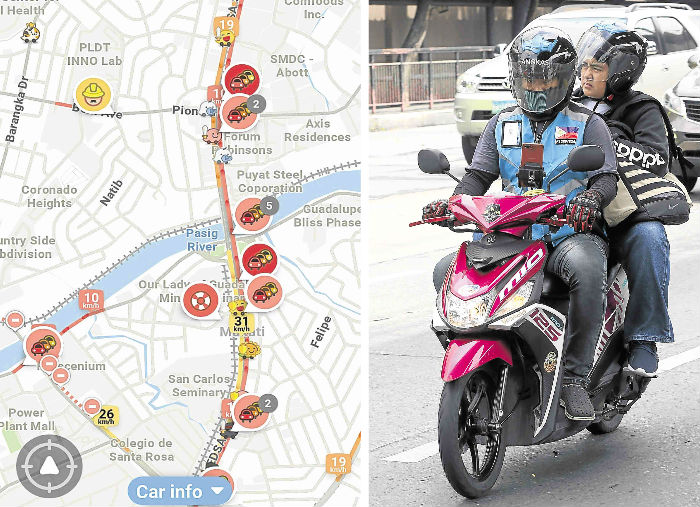Weary commuters turn to Waze, Angkas

TRAFFIC SOLUTIONS The daily struggle to get from Point A to B in Metro Manila has been eased somewhat by online apps Angkas (right) and Waze (left) which, while different in functions, share one purpose: To find shortcuts. —NIÑO JESUS ORBETA
MANILA, Philippines — To survive their daily commute, Metro Manila residents have turned to two online apps designed to help them reach their destinations through the shortest route and in the fastest time possible.
But while Waze and Angkas have become essential tools in the daily struggle to avoid getting stuck in heavy traffic for hours, their growing popularity is also symptomatic of an increasingly worsening problem: The continued deterioration of the country’s public transportation system.
Same purpose
While vastly different in terms of functions, the two online apps share a single purpose: Find shortcuts.
Waze, which currently has 3 million users, is primarily a navigation app that uses crowdsourced information to generate optimized routes that allow users to save on time and money.
“Waze combines the wisdom of the crowd and local municipal data with some machine learning to reflect the most accurate road conditions, find optimized routes in real-time, calculate arrival estimations, and inform future city planning decisions,” Waze country manager Sarah Rodriguez said in an e-mail interview. “Every level of involvement, however small, extends beyond a single drive to impact roads, cities and lives.”
Article continues after this advertisementPatricia Mendez, who has been using Waze almost every day for five years, relies heavily on the app because it generates routes in which the estimated time of arrival is almost always predictable.
Article continues after this advertisementMendez, who works as a reservations officer for a travel agency based in Makati City, uses the navigation app often during peak hours. It helps her avoid congested highways by taking her through residential streets, saving her almost an hour of travel.
“It’s not [accurate] all the time,” she said. “But it does the job.”
Critics, however, point out that Waze merely displaces the traffic into areas not normally traversed by vehicles, like subdivisions and inner roads.
But now, even the Metropolitan Manila Development Authority is pushing for the use of private roads to help decongest the main highways.
Motorcycle taxis
As passengers of four-wheeled vehicles stew in heavy traffic, others breeze through on motorcycle taxis hired through the Angkas app.
Angkas is currently undergoing a six-month pilot test which, if successful, may persuade Congress to amend Republic Act No. 4136, which bars the two-wheelers from being used for public transport.
According to George Royeca, Angkas public affairs head, it takes 35 minutes to traverse 15 kilometers on a regular Angkas ride. Commuter groups have been pushing for the 10-10-10 principle, where it should take one hour to traverse 10 kilometers for a trip to be considered convenient and efficient.
Maia Legson, a web designer working in Taguig City, is a regular Angkas passenger. For a fare of P188, it takes her 20 minutes to reach SM Aura from her house in Libertad. Two jeepney rides (P9 per ride) would take her an hour and a half.
“At first, I was apprehensive because Angkas is expensive (compared to public transport). But when I think about the sacrifices I have to make and the difficulties I have to endure on the road, I think it’s a fair tradeoff.”
Like Legson, 23-year-old Maedelle Vargas has also gotten used to booking an Angkas ride to get to her office in Taguig every day.
“If I commute, it would take me five rides and over an hour to arrive, [plus] I would have to wake up early and leave the house around 6:45 a.m. just to arrive at 8 a.m.,” she said. “Even a normal Grab ride would take an hour and a half while Angkas will take 30-45 minutes.”
But the speed and convenience do not make up for the glaring lack of options for regular commuters, said Dr. John Go of the World Health Organization.
Safety also important
“When we look at Angkas, we shouldn’t simply regard it as the ultimate solution, but also look at why it is being offered and whether there are alternative options,“ he said during a road safety conference. “Moving from Point A to B is important. But moving from Point A to B safely is [also] important.”
For its part, the Department of Transportation (DOTr) maintains that it is doing its best to beef up the country’s public transport system starting with the light rail systems.
The DOTr is currently building several extensions to the existing three major train lines in the metropolis. It is also considering walkways for pedestrians and biker lanes.
But while these projects remain in the pipeline, commuters have no choice but to rely on Waze and Angkas.